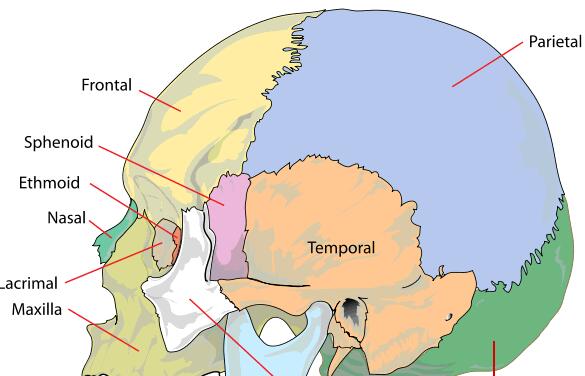中轴骨
The axial skeleton includes the bones in the head, neck, spine, chest and trunk of the body.
中轴骨包括颅骨、颈骨、脊椎骨、胸骨以及躯干骨。
These bones form the central axis for the whole body and protect many of the internal organs such as the brain, lungs, and heart.
上述骨骼构成了骨架的中轴线,起到保护大脑、肺部以及心脏等内脏器官的作用。
The head or skull is divided into two parts consisting of the cranium and facial bones.
头骨被分为颅骨和颜面骨两部分。
These bones protect the brain and special sense organs from injury.
上述骨骼可保护大脑和特殊感觉器官。
The cranium covers the brain and the facial bones surround the mouth, nose, and eyes.
颅骨保护大脑,嘴部、鼻部以及眼部被颜面骨环绕。
Muscles for chewing and head movements are attached to the cranial bones.
用于咀嚼和头部活动的肌肉与颅骨相连。
The cranium consists of the frontal, parietal,temporal, ethmoid, sphenoid, and occipital bones.
脑颅骨又包括额骨、顶骨、颞骨、筛骨、蝶骨和枕骨。
The facial bones are the mandible, maxilla, zygomatic, vomer, palatine, nasal, and lacrimal bones.
颜面骨包括下颚骨、上颌骨、颧骨、犁骨、腭骨、鼻骨以及泪骨。
The cranial and facial bones are described in Table 1.
颅骨和颜面骨描述请见表格一。
The hyoid bone is a single U-shaped bone suspended in the neck between the mandible and larynx.
舌骨为U型骨,舌骨位于颈部, 悬挂在下颔骨与喉头之间。

It is a point of attachment for swallowing and speech muscles.
被看作是咀嚼肌和语言肌的附着点。
The trunk of the body consists of the vertebral column, sternum, and rib cage.
躯干包括脊柱、胸骨以及肋骨篮。
The vertebral or spinal column can be divided into five sections: cervical vertebrae, thoracic vertebrae, lumbar vertebrae, sacrum and coccyx.
脊柱可分为五部分:脊椎骨、胸椎骨、腰椎骨、荐骨以及尾骨。
The rib cage has 12 pairs of ribs attached at the back to the vertebral or spinal column.
肋骨篮包括十二对肋骨,并附着于脊柱后部。
Ten of the pairs are also attached to the breastbone or sternum in the front.
其中十对还附着在胸骨前部。
The remaining two pairs are called floating ribs and are attached only to the vertebral column.
剩余两对称之为浮肋,且仅与脊柱相连。
The rib cage serves to provide support for other organs, such as the heart and lungs.
肋骨篮为心脏,肺部等器官提供支撑。


